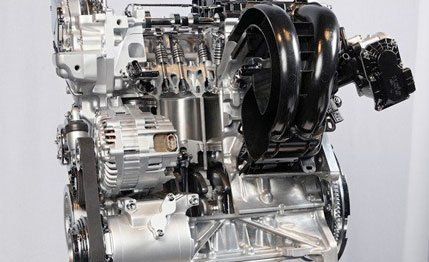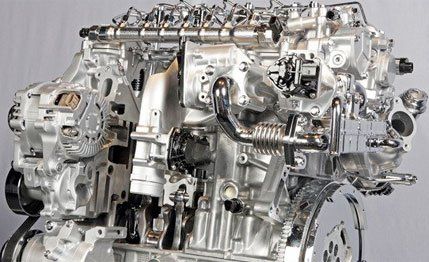Mazda 3 Skyactiv D
Around the world, automakers are grappling with the changes necessary to meet escalating fuel-economy regulations. To this end, Mazda is launching a new family of four-cylinder engines—fours power the vast majority of Mazda's cars—called Sky-G (gasoline) and Sky-D (diesel). We drove both in prototypes of the next-gen Mazda 6 and, thankfully, either engine can be paired with the latest version of Mazda's snick-snick six-speed manual.
We got the deep dive on the 2.0-liter version of the Sky-G, which will launch next year in the U.S., likely as part of a midcycle face lift of the Mazda 6. (A completely new 6 is a few years out yet and will be about 140 pounds lighter than the current car, thanks to meticulous optimization of material thicknesses and mounting points.) In the future, there also will be variations in the 1.3- to 2.5-liter realm, and Mazda has already signed a deal to license Toyota's hybrid technology for a future Sky-based hybrid. Starting from the ground up, Mazda has impressively leapfrogged its previous gas engine, to the tune of estimated EPA fuel-economy ratings in a Sky-equipped Mazda 3 of 30 mpg city and 39 to 40 highway. That's nearly on par with VW's Golf and Jetta diesels as well as best-in-class cars one segment smaller, such as the Ford Fiesta and Chevrolet Cruze. Here's how they did it.
The Big Squeeze
Increasing the compression ratio—in this case, to a staggering 14:1 from 11:1 in the current 2.0-liter (the U.S. version is 10:1)—is a classic way to squeeze more work out of the piston's power stroke. But it creates problems, too, because compressing the air/fuel mixture this much causes excess heat build-up in the cylinder, which leads to premature auto-ignition, or knock. To keep the temperatures down, Mazda employs a seriously lengthy 4-2-1 exhaust header, designed so that the hot exhaust gases don't get pulled back into the next cylinder's intake stroke. As it stands today, it doesn't appear that the Sky could fit in a longitudinal application such as the Miata—the huge header likely would poke through a front fender.

Further improvements include the addition of direct injection and a reduction of heat loss—too much heat can be problematic, but temperature is a necessary byproduct of burning fuel, and squelching it all is inefficient. The heat-loss reduction comes from a smaller bore and a much more complex piston shape that features a cavity directly in the piston's center, the hot area where the spark plug fires. Friction also has been reduced in the pistons, rods, and crankshaft (which is now forged steel instead of cast iron), and roller finger followers reduce it in the valvetrain. The engine uses 0W20 oil, which looks frighteningly like colored water. The Sky also gets dual variable valve timing, electronically varied (as opposed to using oil pressure) on the intake side, so that rapid adjustments can be made even during cold starts. Overall weight has been reduced by about 15 pounds, including 10 saved by thinning out the block where additional strength wasn't needed.
Premium Fuel, Mid-Grade Output
Premium, 91-octane fuel is required for the Sky's not-so-staggering 163 hp at 6000 rpm and 155 lb-ft at 4000, but Mazda is proud of its exceptionally wide torque band for enhanced real-world drivability. To enable running on regular gas, the U.S. version will have a compression ratio of 13:1, which means fuel economy and torque will diminish by about 3 to 5 percent, according to Mazda. The premium-fueled Sky we drove was perfectly adequate in the Mazda 6 prototypes, although acceleration was rather leisurely—far slower than the current Mazda 6 with its 168-hp, 2.5-liter—giving us plenty of time to wish for a bit more smoothness during the extended time in each gear. But being in the lighter Mazda 3 would help, and the tradeoff for near-diesel levels of fuel economy is probably worth it.
Surprisingly, Mazda is passing on today's popular trend of downsized, turbocharged engines—say, a 1.4-liter turbo instead of this 2.0-liter. The company says the next generation of gasoline engines, which will employ HCCI (Homogenous Charge Compression Ignition)—essentially firing a gasoline engine like a diesel, without using the spark plugs—will erode the benefits of downsized engines. Smaller engines reduce pumping losses by operating at a higher load (the throttle is open further) more often. In the same way, HCCI engines will have to flow more air to realize the fuel-saving, lean-combustion benefits of that cycle. Mazda claims that if it downsized the Sky family of engines they wouldn't be able to flow enough air for HCCI without upsizing once again. Plus, as Mazda rightly points out, adding a turbocharger and an intercooler is quite a pricey proposition.

Oil-Burner Exposé
On the diesel side, Mazda has pulled off an even more impressive feat. The 2.2-liter Sky-D (again, other sizes are likely to follow) boosts fuel economy by 20 percent over the current, 2.2-liter diesel and meets Euro 6 and U.S. Tier 2 Bin 5 emissions standards without using any NOx aftertreatment such as urea injection. You catch that? It meets U.S. emissions standards. That's because Mazda is planning to bring this engine here sometime in 2012.
With the diesel, Mazda moved in the opposite direction, decreasing the compression ratio from 16.3:1 down to 14:1. That's the same as the gas-burning Sky-G, and a value that's the lowest in the world among diesels, according to Mazda. Doing so reduces cylinder pressures, and therefore temperatures, which reduces NOx production and also allows the fuel to mix better, avoiding locally rich areas that produce soot. Mazda claims that the lessened friction from the reduced cylinder pressure alone is worth a 4- to 5-percent gain in fuel economy. And the reduced internal forces also allow components such as the rods and pistons to be substantially lighter. Here, too, a forged steel crankshaft replaces a cast-iron unit. Overall weight savings is a whopping 55 pounds.
The downside to lowering the compression ratio of a diesel is that, during warm-up, the engine temperature can be too low to support proper combustion, and misfires result. To get around this, Mazda added a two-stage variable valve-lift system on the exhaust side in order to be able to create additional valve overlap. This causes the hot exhaust gases to be drawn back into the next cylinder to warm it up.

Eat It, Hybrids
Other new features are a sequential twin-turbo arrangement—one small and one large—which outperforms the old single, variable-geometry unit; 12-hole piezo injectors that disperse fuel into the cylinder in exacting quantities during two to eight separate injections per cycle at pressures up to 2900 psi; and an exhaust manifold that's completely integrated into the block. Here, too, fuel-economy claims are impressive: 31 to 33 mpg city and 43 mpg highway for a Mazda 6 with the 2.2-liter diesel. Does an over-40-mpg family sedan sound good to anyone else?
Output beats the gas engine in both regards: 173 hp at 4500 rpm and 310 lb-ft at 2000. Redline has been raised to a screaming (for a diesel) 5200 rpm, versus its predecessor's 4500. And it felt notably quicker than the gas-engined car, pulling strongly throughout the rev range and exhibiting none of the run-out-of-breath feeling that afflicts some diesels as they wind toward the upper end of the tach. It's exceptionally responsive, and quiet, too, with very little clatter, even when accelerating from engine speeds below 1500 rpm.
Automatic Anxiety
In addition to the sweet-shifting six-speed manual, we drove each engine with Mazda's new Sky-drive six-speed automatic, which boasts a more aggressive lock-up clutch for the torque converter, leading to a 4- to 7-percent improvement in fuel economy. Although the calibration was admittedly early in development, the automatic was distinctly less impressive than either of the new engines. In terms of feel, which Mazda claims is much more direct than before, it doesn't seem to stand out from the current crop of high-tech automatics. The wide-open-throttle upshifts struck us as a bit lazy, too, although the downshifts were quite prompt. We'll stick with the manual, thank you very much. Few buyers do, however, which could mean bad things for Mazda's sales.
Perhaps the best thing in all of this, though, is that Mazda's impressive engineering work proves that the internal-combustion engine still has plenty of legs in our ever-more-regulated world.
This content is created and maintained by a third party, and imported onto this page to help users provide their email addresses. You may be able to find more information about this and similar content at piano.io
Source: https://www.caranddriver.com/news/a15129125/mazda-skyactiv-g-and-skyactiv-d-engines-news/







Tidak ada komentar:
Posting Komentar